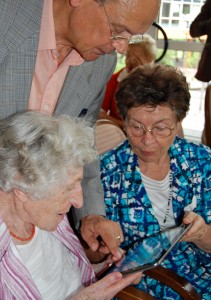The digital divide with Seniors
Many of my technology encounters at the library have been with Seniors. Sometimes the request for help is simple. Sometimes it is complex. In nearly all cases there is a level of frustration. Seniors require a different approach in teaching style. Kids, even when they don’t have access to technology at home, have a natural ability to absorb technology and technology concepts. Demonstrate once how to play a game on a tablet and they are off and running. They explore with no fear gaining skills through trial and error. Seniors on the other hand come in with a lot of fear and trepidation.
One gentleman came in with a brand new Macbook Air and declared, “I’ve only been on the internet once before in my entire life. Can you show me how to get on the internet here.”
A woman came in with a new Windows 8 laptop that her kids had gifted her. Her kids wanted her to sign up and communicate with them through Facebook. But she hadn’t turned on the laptop more than a few times in 6 months because she had no idea how to accomplish such a task. The stress and anxiety of the situation was literally making her sick.
Another older gentleman was recently unemployed. He had worked his entire life as a farm laborer and truck driver. He never needed a computer and had never used one. Now he has to apply for a new job but the application is an online form. Sitting down in front of a computer for the first time to do this was an enormous and overwhelming task.
Some Seniors are very tech savvy but for those who have had very little interaction with technology, I’ve identified a skill set that library staff need in order to help seniors successfully.
1. Recognize Seniors as intelligent, wise, people.
It takes a great deal of humility for someone to come and ask for help. These are people who have a lot of life experience. They have seen technology evolve and used technology that was new and innovative in their working careers. The technological evolution has picked up so much speed in the last 20 years that the change is breath taking. I give a Senior who has never touched a computer in their entire life a lot of kudos for picking up a modern day tablet or sitting down in front of a desktop computer.
2. Identify
Identify what task or tasks the person wants to accomplish. Maybe it is email, Facebook, or typing up a recipe. Maybe it is signing up to read ebooks. Just as we use Reader’s Advisory interviews to identify reading preferences, we can use similar skills to narrow down a specific technology goal. Nearly all modern devices require an email address, passwords, and in many cases a credit card. A tech interview can identify these needs before jumping into the ultimate goal and also give an idea of how much time may be required to get up to speed. Create a plan to work with this person.
3. Demonstrate
Demonstrate how to use a device, such as a tablet, or how to launch a web browser on a computer. But then back out all the way to the beginning and have the patron go through the same steps. You may have to do this several times. You may be asked to write down the steps so they can practice this at home. Resist the temptation to take over and do it for the person.
4. Patience and kindness
It goes without saying that a library staff person should be patient and kind.
5. Follow-up
Sometimes not everything can be accomplished in one setting. Schedule a second session or follow-up as needed. You may also want to identify a family member or friend that can provide further assistance.
Some of my most rewarding experiences have been working with Seniors using technology for the first time. Watching a grandma receive an instant message through Facebook from her granddaughter is something I will always remember. Grandma cried as her granddaughter told her she loved her.
Photo copyright Sigismund von Dobschütz via Wikimedia Commons.


